Statues and Figurines in the Lytham St Annes Art Collection
Link to Bronzes
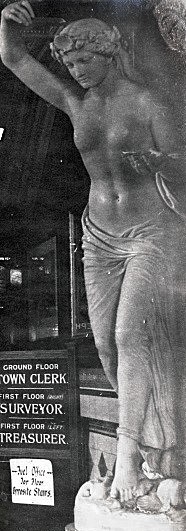
|

Hebe, Goddess of Eternal Youth
Artist Rinaldo Rinaldi |
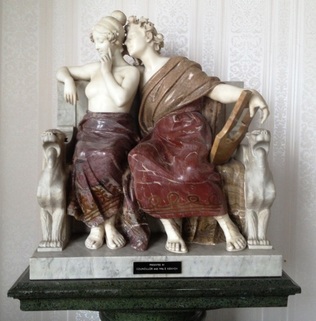
Italian Marble Figurative
Group - Courting Couple (possibly Orpheus and Eurydice) by Artist Ferdinando Vichi |
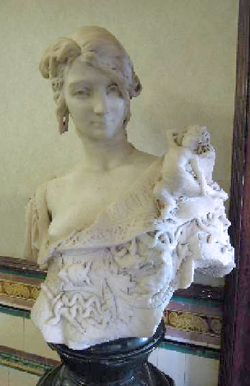
|
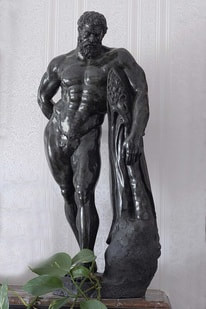
Hercules
Artist unknown
Medium Marble
Size H 80 cm (31.5 in)
Date produced c.216AD (4th century BC for the original)
Donor Alderman and Mrs J H Dawson
Date donated March, 1931
The original Greek bronze, known as the Farnese Hercules, by Lysippos (or one of his circle) survived until it was melted down in 1205 by Crusaders. The massive Glykon copy, made in the early 3rd century and signed by Glykon, whose name is Greek but is otherwise unknown, standing at 3.17
metres (10.5 ft), was made for the Baths of Caracalla in Rome (dedicated 216AD) from where the
statue was recovered in 1546. It is now in the Museo Archeological Nazionale, Naples.
This Italian Verde Antico (antique green) marble full length figure shows Hercules standing beside a rock, weary, leaning on his club, which has the skin of the Nemean lion draped over it. In myths about Heracles, killing the lion was the first task of The Twelve Labours. It has been suggested that he has just performed one of the last tasks as he is concealing apples behind his back, cradled in his right hand, the apples of Hesperides.
Artist unknown
Medium Marble
Size H 80 cm (31.5 in)
Date produced c.216AD (4th century BC for the original)
Donor Alderman and Mrs J H Dawson
Date donated March, 1931
The original Greek bronze, known as the Farnese Hercules, by Lysippos (or one of his circle) survived until it was melted down in 1205 by Crusaders. The massive Glykon copy, made in the early 3rd century and signed by Glykon, whose name is Greek but is otherwise unknown, standing at 3.17
metres (10.5 ft), was made for the Baths of Caracalla in Rome (dedicated 216AD) from where the
statue was recovered in 1546. It is now in the Museo Archeological Nazionale, Naples.
This Italian Verde Antico (antique green) marble full length figure shows Hercules standing beside a rock, weary, leaning on his club, which has the skin of the Nemean lion draped over it. In myths about Heracles, killing the lion was the first task of The Twelve Labours. It has been suggested that he has just performed one of the last tasks as he is concealing apples behind his back, cradled in his right hand, the apples of Hesperides.
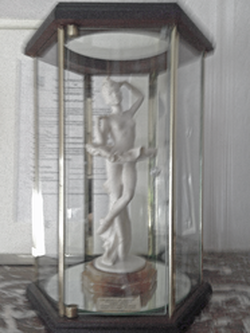
Ballet Dancer
Artist unknown
Medium Glass and Plastic
Size
Date produced c.2013
Donor Wynne Hodge Smith commemorating
Lytham St Annes Dance Festival
Date donated March 2013
Artist unknown
Medium Glass and Plastic
Size
Date produced c.2013
Donor Wynne Hodge Smith commemorating
Lytham St Annes Dance Festival
Date donated March 2013
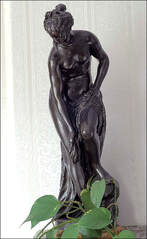
Venus
Artist Christophe-Gabriel Allegrain (after) Artist dates 1710-1795 Medium unknown Donor Mrs Eva Dickinson 1886-1949 Balmoral Road Lytham St Annes Donated 2 October 1936 Apollo Artist unknown Medium unknown Donor Mrs Eva Dickinson 1886-1949 Balmoral Road Lytham St Annes Donated 2 October 1936 Both the above unlocated at the present time |
Socrates
Artist unknown Medium unknown Donor Mrs C Turner-Gresley, Balmoral Road, Lytham St Annes Date donated 31 May 1940 Unlocated at the present time Shakespeare Artist James Howell & Co after model by F M Miller 1864 Medium Parian ware Size unknown Donor Mary Eliza Garlick 1865-1937 and her sister Kate Howard Garlick 1867-1948 Park Road, Lytham St Annes Date donated 2 November 1936 awaiting image The Rt Hon W E Gladstone
Artists unknown Medium Marble & Ceramic Donor Mary Eliza Garlick (1865-1937) and sister Kate Howard Garlick (1867-1948) Newholme, 45 Park Road, Lytham St Annes Date donated 2 November 1936 Unlocated at present time |
